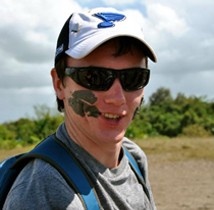Darragh O'Connor

B.Sc., Honours Earth Sciences, HÂþ» University (2011)
M.Sc. Thesis
(PDF - 19.4 Mb)
This study investigates the sedimentology, provenance, diagenesis, and reservoir characteristics of Late Triassic synrift successions from the Wolfville and Chedabucto formations along the margins of the Minas Basin and Chedabucto Bay and the Eurydice Formation in offshore subsurface regions of the Orpheus Graben. The strata were examined in outcrop and with thin section petrography, X-ray fluorescence, and handheld permeability and gamma ray (radioactivity) tools.
Outcrop examination revealed different stages of rifting and fluvial sedimentation deposited in successions at Rainy Cove (early stage rifting) and McCaul Island (early to middle stage rifting). Synrift successions from the Eurydice P-36 well in the Orpheus Graben revealed finer grained successions with evidence suggesting sedimentation occurred within an estuarine environment during the late stages of rifting.
X-ray fluorescence revealed that the fluvial Wolfville Formation (Rainy Cove) samples plot in the ‘wacke’, ‘litharenite’, and ‘Fe-sand’ field, the aeolian Wolfville Formation (Red Head) samples predominantly plot in the ‘sublitharenite’ field, and the Chedabucto Formation plots predominantly in the ‘sublitharenite’ and ‘litharenite’ fields. Major element composition plots of sands discriminate between passive margin, active continental margin, continental arc, and oceanic arc tectonic setting. Points from the fluvial Wolfville Formation are generally spread within or near the active continental margin field. Whereas the aeolian Wolfville Formation generally plot in or near the passive margin field. Points from the Chedabucto Formation are spread but generally can be found in the passive margin to active continental margin fields.
Point count analyses show that the aeolian and fluvial successions from the Wolfville and Chedabucto formations all plot within the recycled orogen fields of the provenance indicator ternary diagrams. QtFL classification after Folk (1968) reveals that the fluvial Wolfville Formation plots in the ‘litharenite’ to ‘feldspathic litharenite’ fields, the aeolian successions plot in the ‘sublitharenite’ field, and the Chedabucto Formation plots in the “sublithic arenite’ to ‘litharenite’ fields.
Thin section microphotographs show porosity and reservoir quality for samples from each of the study areas The Eurydice Formation is dominated by silt sized grains, contains some large lithic clasts and sand grains, and shows very poor porosity. Within the Chedabucto Formation, sand dominated beds show very-fine to coarse grain size, are moderately sorted, and can be well cemented with no porosity to highly porous with no indication of cementation. The fluvial Wolfville Formation comprises coarse grained, subangular to angular sands that are typically well cemented in a calcite cement. Secondary porosity is from alteration of feldspar grains in the fluvial Wolfville Formation. The aeolian Wolfville Formation comprises very fine to very coarse grained sands, that are subangular to subrounded and show high porosity with sparse calcite and iron oxide cementation.
Keywords: Triassic, Rift, Atlantic Canada, Nova Scotia, Fluvial Architecture, Reservoir Quality, Chedabucto Formation, Wolfville Formation, Eurydice Formation
Pages: 206
Supervisor: Grant Wach



